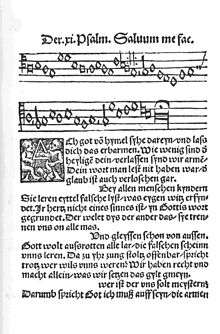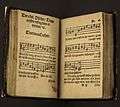Ach Gott, vom Himmel sieh darein
| "Ach Gott, vom Himmel sieh darein" | |
|---|---|
| Hymn by Martin Luther | |
 Der XI. Psalm Salvum me fac, Erfurt Enchiridion, 1524 | |
| English | Oh God, look down from heaven |
| Text | by Martin Luther |
| Language | German |
| Published | 1524 |

"Ach Gott, vom Himmel sieh darein" ("Oh God, look down from heaven") is a Lutheran chorale of 1524, with words written by Martin Luther paraphrasing Psalm 12. It was published as one of eight songs in 1524 in the first Lutheran hymnal, the Achtliederbuch, which contained four songs by Luther, three by Speratus, and one by Justus Jonas. It was contained in 1524 in the Erfurt Enchiridion. It is part of many hymnals, also in translations. The text inspired vocal and organ music by composers such as Heinrich Schütz, who set it as part of his Becker Psalter, and Johann Sebastian Bach, who based a chorale cantata on it. Mozart used one of its tunes in his opera The Magic Flute.
History and text
At the end of 1523, Luther paraphrased Psalm 12 (Psalm 11 in Vulgata numbering), Psalms 12, in Latin Salvum me fac, attempting to make the psalms accessible to Protestant church services in German. Luther's poetry first follows the verses of the psalm exactly, then combines two verses to one. He expands the content of the psalm to show the precise situation of the early Reformation as a time of conflict.[1]
The hymn was first printed as one page inserted in the Wittenberger Dreiliederblatt (lost). It was one of eight hymns of the first Lutheran hymnal, published 1524 in Nuremberg under the title Etlich Cristlich lider (Some Christian songs), also called Achtliederbuch. The same year it appeared in Erfurt in Eyn Enchiridion.[2][3] The hymn was soon used as a Protestant Kampflied (battle song).
The chorale became the Lutheran Hauptlied (main hymn) for the second Sunday after Trinity.
Melody
In the first Lutheran hymnal the melody was the same as for "Es ist das Heil uns kommen her" by Paul Speratus.[4][3] In Johann Walter's hymnal Eyn geystlich Gesangk Buchleyn in Wittenberg in 1524, it appeared with a different melody.[3] In the Erfurt Enchiridion, also in 1524, the text first appeared with a tune codified by Martin Luther,[5] which was derived from the secular song "Begierlich in dem Herzen mein" (The lustful desires in my heart) from about 1410. This melody is in Phrygian mode, preferred by Luther for texts of repentance, such as "Aus tiefer Not schrei ich zu dir".[3]
Musical settings
The Phrygian melody which Luther probably wrote or at least influenced was set by composers for instruments like harpsichord and organ, and for voices.
Instrumental
Jan Pieterszoon Sweelinck composed a piece for harpsichord, elaborating on the tune.[6]Johann Pachelbel composed two chorale preludes for organ as part of "Erster Theil etlicher Choräle (Choräle zum praeambuliren)" before 1693. Johann Sebastian Bach wrote a chorale prelude, BWV 741.
Vocal
Heinrich Schütz set the chorale as part of his Becker Psalter. Bach used the complete chorale as the base for his chorale cantata Ach Gott, vom Himmel sieh darein, BWV 2 (1724). Wilhelm Friedemann Bach set the chorale as a sacred cantata (BR F19). Felix Mendelssohn composed in 1832 a chorale cantata for baritone, mixed choir and orchestra.
Mozart used the melody in his opera Die Zauberflöte in act 2, Finale, scene 10, when the two "Geharnischte" (men in armour) recite it in unison on Schikaneder's words "Der, welcher wandert diese Strasse voll Beschwerden" as a cantus firmus of a Baroque-style chorale prelude. Alfred Einstein comments in his biography Mozart / His Character, His Work:
In the second act it is the final test of the lovers, the "'test of fire and water", for which Mozart called into play every musical means at his disposal and for which he ordained extreme simplicity, extreme mastery; the scene of the men in armor, which he constructed in the form of a chorale prelude, building upon a solemn fugato around the chorale Ach Gott, vom Himmel sieh darein ...[7]
See also
References
- ↑ Paul Hofreiter (1995). "Johann Sebastian Bach and Scripture / O God, from Heaven Look Down" (PDF). Concordia Theological Quarterly, Volume 59, No. 2. Retrieved 5 August 2011.
- ↑ "Ach Gott, vom Himmel sieh darein / Text and Translation of Chorale". bach-cantatas.com. 2005. Retrieved 4 August 2011.
- 1 2 3 4 "Chorale Melodies used in Bach's Vocal Works / Ach Gott, vom Himmel sieh darein". bach-cantatas.com. 2006. Retrieved 4 August 2011.
- ↑ Crist, Stephen A. Early Lutheran Hymnals and Other Musical Sources in the Kessler Reformation Collection at Emory University, Notes - Volume 63, Number 3, March 2007, pp. 503-528.
- ↑ Julian, John, ed., A Dictionary of Hymnology: Setting forth the Origin and History of Christian Hymns of all Ages and Nations, Second revised edition, 2 vols., n.p., 1907, reprint, New York: Dover Publications, Inc., 1957, 1:322-25
- ↑ Christopher Brodersen (2011). "Sweelinck, J.P.: Harpsichord Works". Fanfare. Retrieved 6 August 2011.
- ↑ Mozart His Character, His Work. Oxford University Press, quoted at raptusassociation.org, Mozart's Magic Flute: Comments and Music Criticism. 1961. Retrieved 6 August 2011.
External links
| Wikimedia Commons has media related to Ach Gott, vom Himmel sieh darein. |
| German Wikisource has original text related to this article: |
- O Lord, look down from heaven CyberHymnal 2011
- Look Down, O Lord, From Heaven Behold (also known as O God, from Heaven Look Down or O God, Look Down from Heaven and See) openhymnal.org 2009
